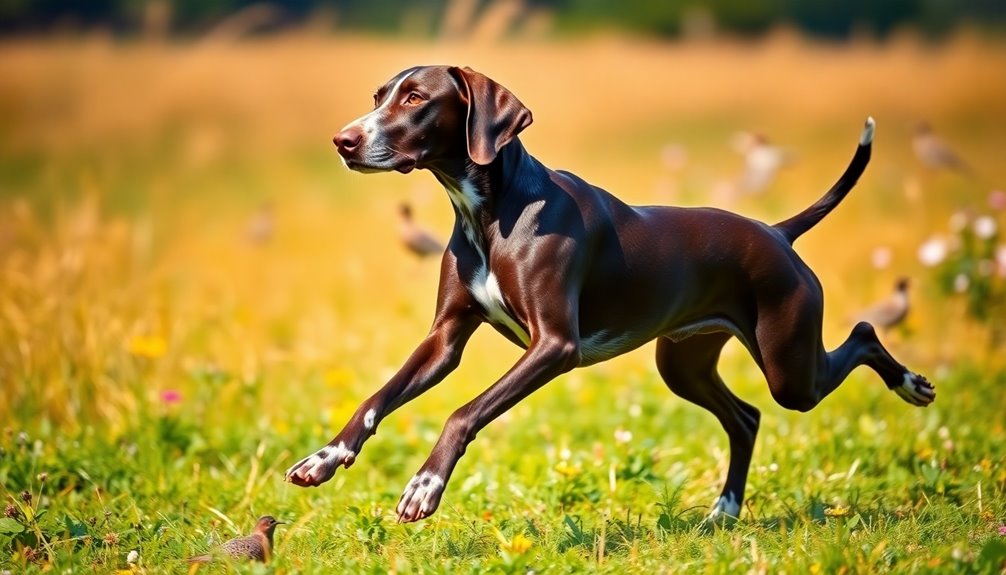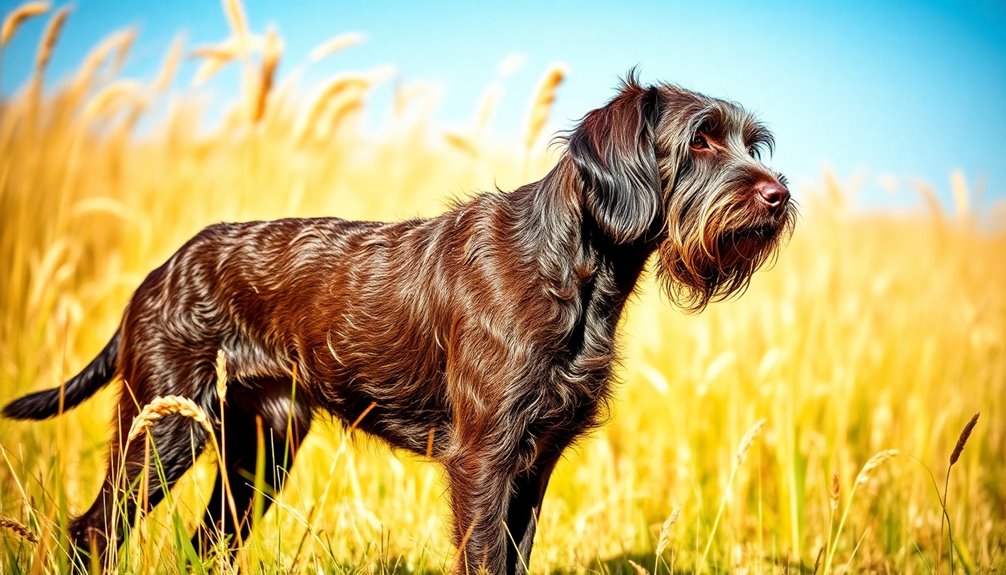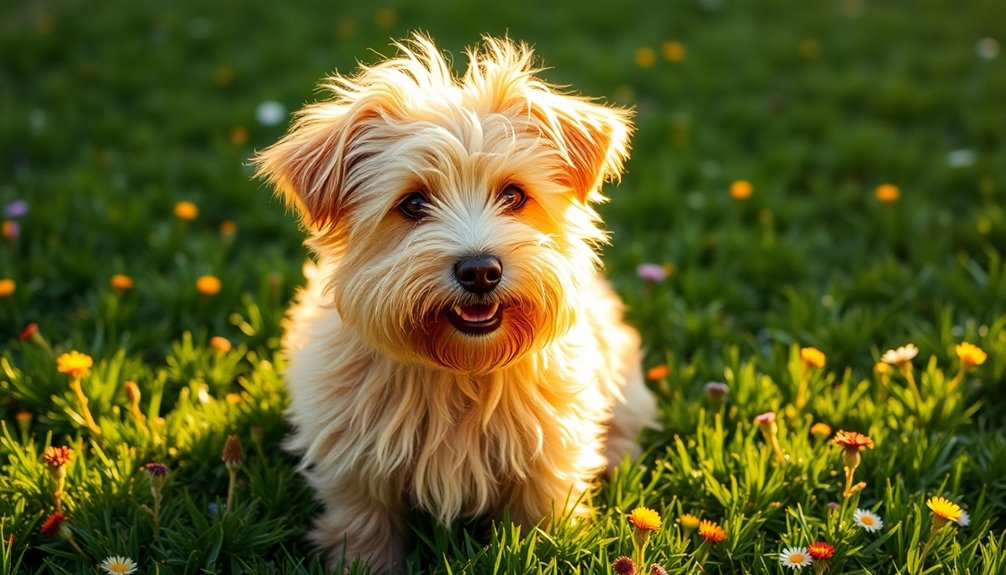The German Shorthaired Pointer is the ultimate versatile hunter, ready for any adventure you throw their way. With athletic builds and a friendly disposition, these dogs thrive in a variety of terrains, from upland fields to waterfowl marshes. They're agile and adept at pointing, retrieving, and trailing game, making them an ideal companion for hunters like you. GSPs need regular exercise and mental stimulation, so be prepared for daily activities. Their strong social nature ensures they bond closely with your family. Discover how this breed's unique traits make them the perfect partner in the field and at home.
Key Takeaways
- German Shorthaired Pointers excel in pointing, retrieving, and trailing various game, making them highly versatile hunting companions.
- Their strong swimming ability and webbed feet enable effective hunting in waterfowl environments.
- Originating from 17th-century Germany, GSPs were bred for adaptability and skill in diverse hunting scenarios.
- GSPs require significant exercise and mental stimulation to maintain their energy levels and prevent behavioral issues.
- Early socialization and consistent training enhance their hunting skills and ensure compatibility with families and other pets.
Introduction
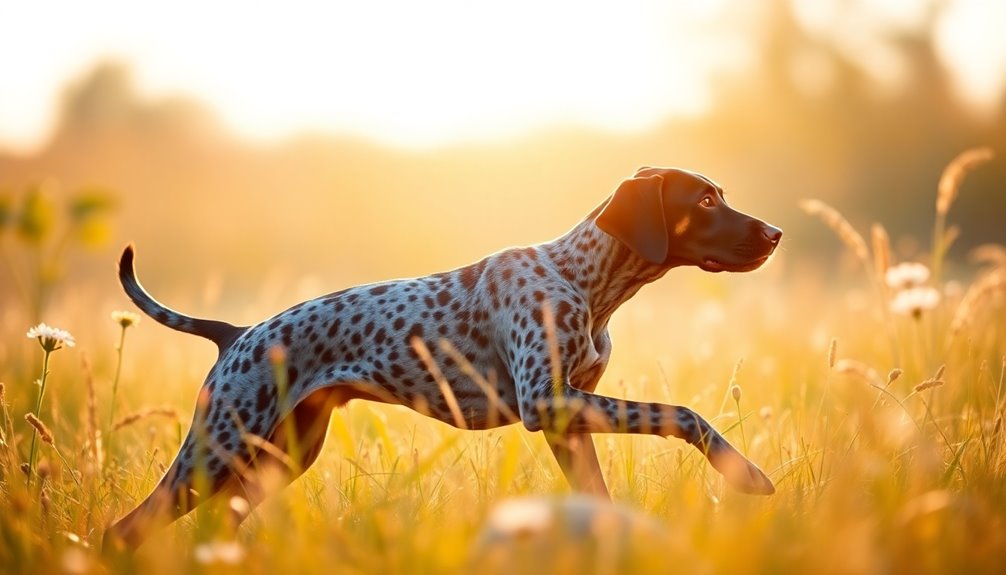
The German Shorthaired Pointer is a remarkable breed that stands out for its versatility and friendly disposition. Standing between 21 to 25 inches tall and weighing 45 to 70 pounds, this breed is both strong and agile. With its dense, short coat in shades of liver, black, or a combination, it's not just a striking dog but also one that requires minimal grooming.
You'll find that these dogs are incredibly friendly and outgoing, forming strong bonds with family members and getting along well with children and other pets. Their intelligence and energy levels mean they need regular exercise—over 40 minutes a day is ideal. While they make excellent companions, they can be easily distracted, so consistent training is key. These dogs are known for their very energetic nature, which makes them perfect for active families.
Known for their versatility, these dogs excel in various hunting roles, from pointing to retrieving. Their powerful endurance and exceptional scenting abilities make them effective hunters for game like upland birds and waterfowl.
Plus, they've a natural affinity for water work, showcasing their adaptability. With a lifespan of 12 to 14 years, the German Shorthaired Pointer is a loyal and active addition to any family.
History and Origin
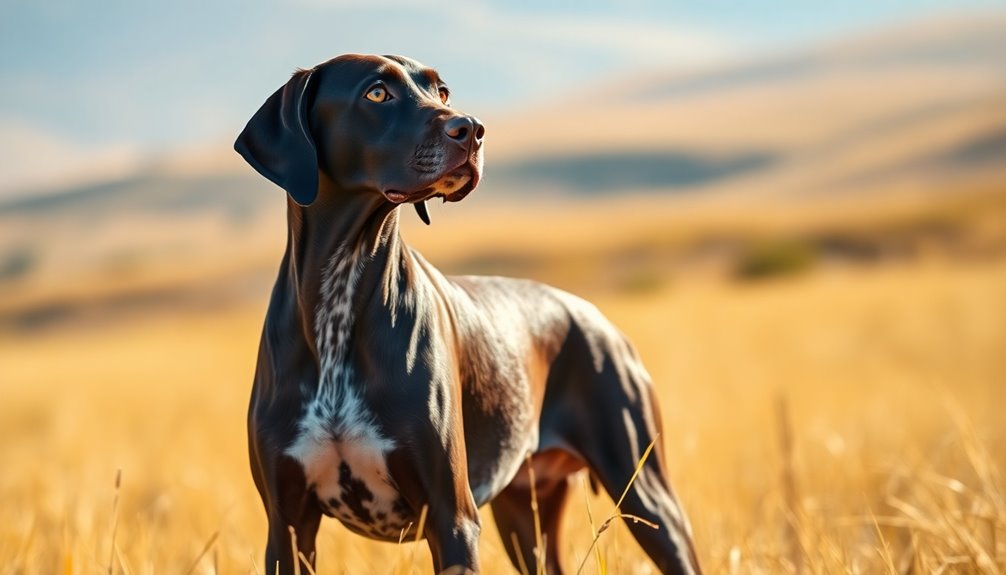
The German Shorthaired Pointer traces its roots back to 17th-century Germany, where hunters aimed to create a versatile dog for various types of game. By blending different breeds, they crafted a skilled companion that could point, retrieve, and excel in diverse hunting conditions. This breed's rich history highlights its evolution into one of the most adaptable hunting dogs today. The breed is likely descended from the German Bird Dog, Old Spanish Pointer, and Hannover Hound, showcasing its diverse lineage.
Where and when the breed originated
Pointing dogs have a long and storied history in Europe, with origins tracing back to the 13th century. The German Shorthaired Pointer (GSP) likely descended from the German Bird Dog, a blend of earlier breeds, including the Old Spanish Pointer and Hannover Hound.
As Spanish, French, and Italian pointing dogs influenced the development of regional German bird dogs, the close contact between Germanic and Hispanic cultures facilitated the introduction of Spanish breeds into Germany.
By the 1600s, crossbreeding began in earnest, aiming to create a versatile hunting dog adept at handling various game in diverse terrains. German hunters selectively bred traditional continental pointers, German tracking hounds, and English Pointers to enhance desired traits. This effort was driven by the need for a dog capable of retrieving game on land and in water.
This effort gained momentum as the German Empire transformed, granting increased hunting privileges to the middle class.
The GSP's official recognition took shape in the late 19th century, with the first registration occurring in the German Kennel Club Stud Book in 1872. Foundation dogs like Nero and Treff played pivotal roles in establishing the breed, leading to the formation of the Klub Kurzhaar in 1880, which standardized the GSP's traits and characteristics.
Versatile Hunting and Retrieving
Versatile hunting and retrieving are at the core of what makes the German Shorthaired Pointer a beloved companion for hunters. With their exceptional abilities, these dogs excel in pointing, retrieving, and trailing a variety of game, from upland birds to deer.
You'll notice their remarkable pointing skills as they freeze in position upon detecting game, showcasing their keen sense of smell and innate prey drive.
The GSP's physical attributes enhance their hunting capabilities. Those webbed feet provide excellent propulsion in water, making them proficient swimmers, while their strong legs and endurance allow for long-distance hunting across diverse terrains. Additionally, their adaptability in various hunting environments underscores their versatility as gun dogs.
Their expressive brown eyes reflect intelligence, crucial for effective hunting.
Training a GSP is often straightforward, as many can hunt right out of the "box." Introducing them to live quail at a young age helps develop their pointing and retrieving skills.
With high energy levels and a friendly temperament, they thrive with regular mental and physical stimulation. Their performance in AKC Hunt tests and various dog sports further showcases their versatility, making them reliable and enduring partners in the field.
Physical Characteristics
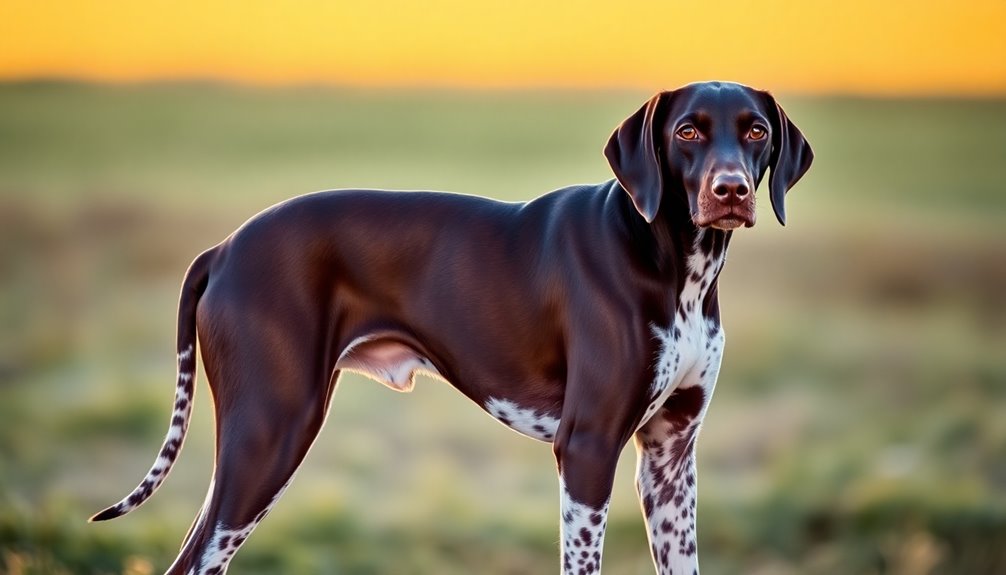
When you look at a German Shorthaired Pointer, you'll notice their impressive size and athletic build, standing 21 to 25 inches tall and weighing between 45 to 70 pounds. Their short, dense coat can come in various colors, often featuring unique spotty patterns that add to their charm. This breed's physical traits not only make them striking but also highlight their capabilities as versatile working dogs. Additionally, they are renowned as an uncontested champion in hunting competitions worldwide, showcasing their exceptional skills and agility.
Size, weight, and coat details
The German Shorthaired Pointer stands out with its impressive size and athletic build, making it an ideal companion for active individuals. Males typically measure between 23 to 25 inches at the withers, while females range from 21 to 23 inches. When fully standing, their height can reach 27 to 32 inches.
You'll notice a significant size difference between the sexes, with males weighing between 55 to 70 pounds and females ranging from 45 to 60 pounds. This breed falls into the medium-sized to medium-large category, boasting an overall body length of 30 to 36 inches.
The German Shorthaired Pointer's athletic build features strong legs, which contribute to its remarkable endurance and physical prowess, perfectly suited for various outdoor activities. This breed is known for its high energy levels, requiring 1-2 hours of daily exercise to maintain its health.
You'll appreciate the broad muzzle and moderately long floppy ears that add to its distinctive look. The coat is short, flat, and dense, providing protection from different weather conditions.
Its sleek and visually appealing appearance, with liver and white color combinations, enhances the breed's charm, making it a popular choice among dog enthusiasts.
Spotty Coat Patterns
With a dazzling array of spotty coat patterns, the German Shorthaired Pointer showcases its unique physical characteristics that not only enhance its beauty but also serve a practical purpose.
The most common coat color combination features a rich liver base with striking white markings, while a solid liver coat highlights the dog's athletic build. Less frequently, you'll see the handsome black and white pattern, which creates a bold contrast.
These dogs can also have roan patterns, where colored and white hairs blend, giving a mottled appearance. The liver roan appears as a soft reddish-grey, while the black roan takes on a blueish-grey tone.
Ticking patterns, with small isolated colored areas on a white background, enhance camouflage, especially in snowy or grassy environments. Additionally, the dense, water-resistant coat provides protection in various terrains, making them well-suited for field work.
Each coat pattern not only contributes to the breed's aesthetic charm but also improves hunting efficiency.
Liver and liver roan patterns excel in wooded landscapes, while black and black roan colors shine in darker terrains. These variations provide the German Shorthaired Pointer with the ability to blend seamlessly into diverse environments, making them not just stunning but also highly functional hunters.
Temperament and Personality
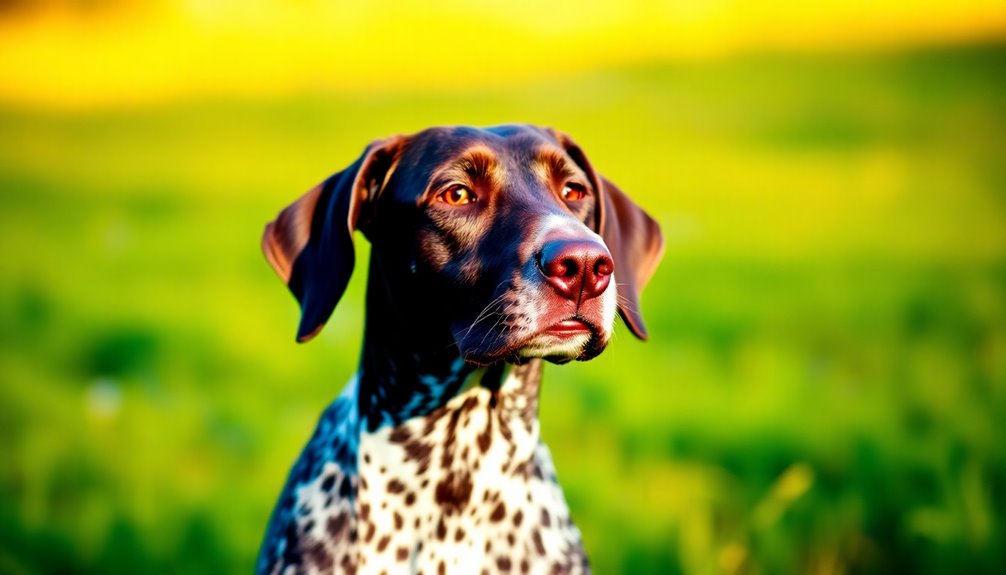
The German Shorthaired Pointer is known for its playful and intelligent nature, making it a joy to have around. Whether you're a family with kids or an individual seeking companionship, this breed forms strong bonds and thrives on interaction. However, if you have other pets, early socialization is key to ensuring a harmonious household. Their high energy levels require significant exercise and attention, making them ideal partners for active families.
Playful and Intelligent Nature
German Shorthaired Pointers embody a perfect blend of playfulness and intelligence that makes them exceptional companions.
These dogs are highly receptive to training, thriving on the mental stimulation it provides. Their eagerness to please and natural athleticism means they're quick learners, mastering various commands and activities like hunting and agility with ease. Their high energy levels require at least one hour of vigorous exercise daily to maintain their well-being. Engaging them with educational toys can further enhance their cognitive skills and keep them mentally stimulated.
With their strong desire to engage, GSPs need plenty of exercise; at least two good sessions each day. Without enough physical and mental activities, they can get bored and potentially destructive. Activities like jogging, hiking, or participating in canine sports are ideal for keeping them happy and healthy.
Their affectionate and social nature means they bond closely with families and enjoy being around people. GSPs are friendly and often welcome strangers, making them approachable and loving dogs.
While they do have a bit of an independent streak, early obedience training helps them become well-mannered companions.
Ultimately, their playful spirit combined with their keen intelligence not only makes them great hunters but also delightful pets that thrive on companionship and activity.
Suitability for families, individuals, or other pets
GSPs are fantastic companions for families, individuals, and even other pets, thanks to their friendly and adaptable nature. They bond strongly with their families and are especially good with children when socialized early. This breed thrives on human interaction and can get along well in various family dynamics, whether you're a single owner or part of a large family. Additionally, their intelligence and eagerness to please make them highly trainable, which enhances their compatibility with families.
However, they do require regular exercise and mental stimulation to keep them happy and prevent destructive behavior.
For individuals, GSPs are perfect if you lead an active lifestyle. They need plenty of physical activity and enjoy outdoor adventures like hiking or running. If you're willing to invest time in training and socialization, you'll find they integrate well into your life.
When it comes to other pets, GSPs can coexist peacefully with dogs, provided they're socialized from a young age. However, their strong prey drive might make them unsuitable for homes with smaller pets like cats.
Health and Lifespan
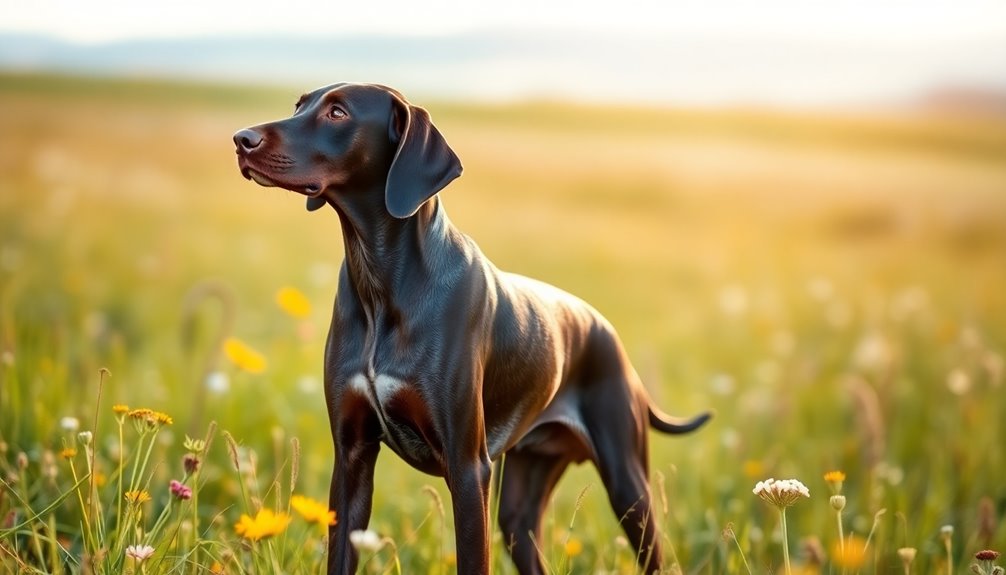
When you bring a German Shorthaired Pointer into your life, understanding their health and lifespan is crucial. Typically, these dogs live between 10 to 14 years, but their longevity can be influenced by factors like diet and exercise. You'll also want to be aware of common health concerns, such as hip dysplasia and hypothyroidism, to keep your pup thriving. Regular health check-ups and certification of parents for health can also help reduce the risk of inherited health conditions in your German Shorthaired Pointer.
Typical lifespan of the breed
The typical lifespan of a German Shorthaired Pointer ranges from 12 to 14 years, making them a relatively long-lived breed among medium-sized dogs. Some sources suggest a slightly shorter average lifespan of 10 to 12 years, but with proper care, many can thrive well into their teenage years.
Several factors influence their lifespan, with genetics playing a crucial role. Your dog's environment, including climate and living conditions, also impacts their overall health.
Providing a balanced and nutritious diet, tailored to their age, size, and activity level, is essential. Aim to feed them high-quality dog food, divided into two meals of 2 to 3 cups per day, while ensuring fresh water is always available. Additionally, maintaining a regular exercise routine can significantly enhance their overall health and longevity.
Regular veterinary care, including check-ups and preventive treatments, is vital for keeping your German Shorthaired Pointer healthy. Adequate physical activity and mental stimulation are necessary to maintain their well-being.
As they age, typically around seven years, adjustments in diet and exercise become important. Taking these steps can help ensure your German Shorthaired Pointer lives a long, healthy life full of adventures.
Common health concerns or genetic predispositions
While German Shorthaired Pointers can enjoy a long lifespan with proper care, they're also prone to several health concerns and genetic predispositions that owners should be aware of.
One major concern is hip dysplasia, a painful malformation of the hip socket that often requires costly surgery. Osteochondrosis dissecans (OCD) can also develop in young dogs, causing joint pain and lameness. Additionally, cruciate ligament disease may lead to painful injuries that necessitate surgical intervention.
You should also be vigilant about neurological issues such as degenerative myelopathy, which affects the spinal cord, and hereditary sensory autonomic neuropathy, a rare condition impacting pain sensation. Active families should ensure their GSP receives appropriate exercise to help maintain joint health and prevent weight-related issues.
Heart disease, including subaortic stenosis and von Willebrand disease type II, can also affect your dog's health.
Cancer is another serious concern, accounting for a significant number of deaths in the breed, particularly in females.
Lastly, don't overlook skin and ear infections, allergies, and eye diseases, which are common in German Shorthaired Pointers. Staying informed about these conditions can help you take proactive steps to maintain your dog's health and well-being.
Tips for maintaining health and wellness
Maintaining your German Shorthaired Pointer's health and wellness involves a combination of regular veterinary care, balanced nutrition, and consistent exercise. Schedule annual check-ups to ensure thorough physical examinations and routine tests that help detect health issues early. Your vet can also provide valuable advice on nutrition, exercise, and preventive care.
A high-protein diet is essential for your energetic dog. Aim for breed-specific food appropriate for their age and size, typically feeding 2-3 cups per day divided into two meals. Always have fresh water available, and consider joint-specific care like chews and multivitamins to support their active lifestyle. Additionally, be aware of breed-specific health concerns to tailor your care accordingly. Including natural remedies in their diet can also support overall wellness.
Exercise is crucial for keeping your German Shorthaired Pointer physically fit and mentally stimulated. Engage in activities like running, hiking, and interactive games to channel their energy and prevent behavioral issues. A consistent exercise routine is vital for their happiness.
Additionally, practice good grooming habits by brushing their coat weekly and bathing them monthly with a moisturizing shampoo. Clean their ears weekly and attend to any skin irritations.
Don't forget to maintain a proper dental care routine to promote oral health, ensuring your furry friend stays healthy and happy.
Care Requirements
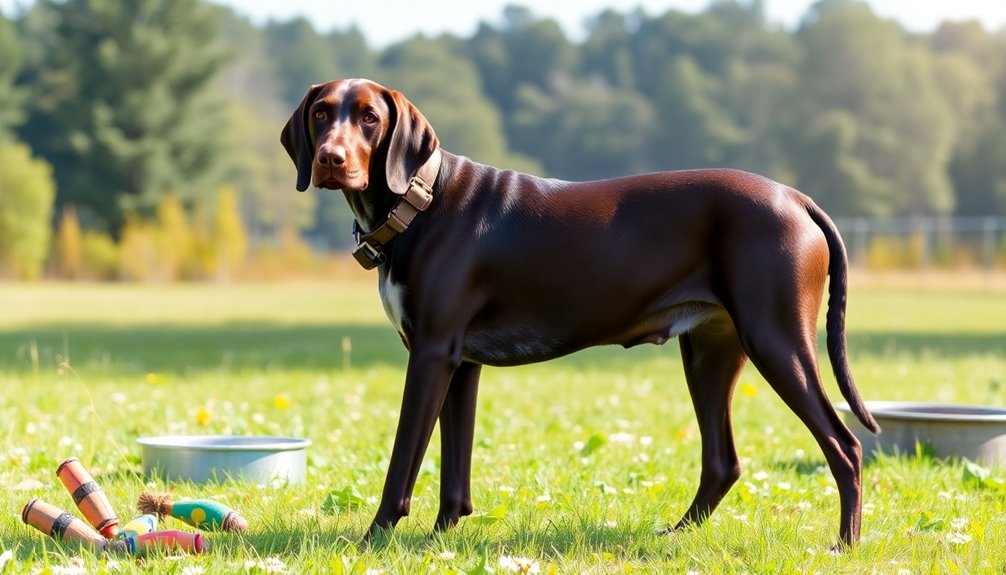
Caring for your German Shorthaired Pointer involves regular brushing to manage their minimal shedding and keep their coat healthy. During heavy shedding seasons, using a pin rake can effectively remove trapped hair. You'll also need to ensure they get plenty of vigorous exercise to match their high energy levels. Lastly, paying attention to their diet will help maintain their overall health and well-being.
Minimal Shedding, Easy Brushing
For many dog owners, managing shedding is a significant concern, but the German Shorthaired Pointer offers a relatively low-maintenance coat. These dogs shed throughout the year, with increased shedding during spring and autumn. In warmer climates, you might notice more consistent shedding, while winter shedding is typically less intense due to their thinner fur. This shedding helps your dog adjust to seasonal temperature changes and is influenced by their high energy levels.
To keep your German Shorthaired Pointer's coat healthy and reduce shedding, brush them at least once a week. Using a firm-bristled brush or a rubber grooming mitt is recommended for their short coat. Regular brushing not only helps distribute natural oils, promoting a shiny appearance, but also allows you to bond with your dog while checking for any health issues. During shedding seasons, you might want to increase brushing frequency to manage excess hair.
Bathing should happen every 3 to 4 months or as needed, depending on their activity level. Remember to use a mild, dog-specific shampoo to avoid stripping the coat of its natural oils. With these simple grooming practices, you can keep your German Shorthaired Pointer looking and feeling great.
Exercise requirements and energy levels
German Shorthaired Pointers are high-energy dogs that thrive on regular exercise and mental stimulation. To keep your GSP happy and healthy, aim for at least 1 to 2 hours of exercise daily. Regular exercise is crucial for preventing behavioral issues that can arise from insufficient physical activity.
Keep in mind that the exercise needs can vary based on age, health, and energy level. Puppies and young GSPs will need more frequent, vigorous activity, while seniors may require a more moderate routine.
Incorporate a variety of activities into your GSP's exercise regimen. Walking and jogging are great for bonding, while fetch, tug-of-war, and hide-and-seek are fun interactive games.
Swimming offers a low-impact option, especially during warmer months, while hiking and trail running leverage their natural endurance. Engaging in dog sports like agility and tracking can provide both physical and mental stimulation.
Mental stimulation is just as vital. Activities like scent work, obedience training, and puzzle games keep your GSP mentally sharp and prevent boredom.
Remember, consistent exercise helps prevent obesity and behavioral issues. It also channels their natural instincts, keeping them calm and well-behaved.
Always monitor for signs of heat exhaustion during outdoor activities, especially in hot weather.
Feeding tips and diet recommendations
When it comes to feeding your German Shorthaired Pointer, understanding their nutritional needs is crucial for maintaining their health and energy levels. These dogs require high-quality proteins, so look for food with real meat like chicken, beef, or fish as the primary ingredient.
Essential fats, especially Omega-3 and Omega-6, are vital for energy and a healthy coat. Complex carbohydrates such as sweet potatoes, brown rice, and oats provide sustained energy, while vitamins and minerals support overall health. High protein content in select dry foods (38%) supports muscle health, making it essential for active breeds like the GSP.
When choosing food, consider your dog's age, activity level, and any specific health concerns. High-quality commercial foods formulated for active breeds are recommended. Avoid fillers like corn or wheat, and opt for grain-free options if necessary. For raw or homemade diets, consult a veterinarian.
For feeding schedules, adult German Shorthaired Pointers typically need 2-4 cups of dry food per day, split into two meals. Puppies under six months require 3-4 meals daily.
Always provide fresh, clean water and consider supplements like fish oil for coat health and glucosamine for joints. Adjust portions based on your dog's activity level to prevent obesity.
Training and Socialization

Training your German Shorthaired Pointer requires consistency to help them become highly trainable. As you gradually introduce them to new friends, you'll build their confidence and social skills. You'll also need to focus on impulse control during training to ensure they respond well to commands. Regular exercise is crucial as it contributes to their high energy levels, making training sessions more effective and enjoyable for both you and your dog.
Highly Trainable With Consistency
With consistency in your approach, you'll find that German Shorthaired Pointers are highly trainable companions. Establish a routine early on, including regular meal times, walks, and training sessions. This structure helps your dog feel secure and understand what to expect.
Set a consistent bedtime routine and use the same commands for each action to avoid confusion.
Incorporate positive reinforcement techniques to motivate your dog. Use treats, praise, and toys to reward good behavior, ensuring you time the rewards correctly to reinforce the behavior. As your dog learns, gradually reduce treats while maintaining verbal praise and play as rewards.
Make sure all family members use the same commands and rewards to create a cohesive training environment. Start training sessions short and frequent to keep your dog engaged, and incorporate mental stimulation activities like hiding treats or puzzle toys. Additionally, it's important to start early with socialization to help your dog develop confidence around new experiences.
Remember, leash training should begin early to prepare your dog for walks and social interactions. Avoid punishment-based methods, as these can lead to fear or aggression.
With your consistent efforts, you'll unlock the full potential of your German Shorthaired Pointer, fostering a well-behaved and eager-to-learn companion.
Gradual Introductions to New Friends
To help your German Shorthaired Pointer thrive, socialization is just as important as training. Start by introducing your puppy to people of different ages, sizes, and ethnicities. Ensure these interactions are positive and rewarding to build confidence and prevent anxieties or biases.
Begin in less stimulating environments, gradually moving to more complex settings. Arrange playdates with other vaccinated puppies or friendly adult dogs, and introduce your puppy to other animals like cats and birds in a controlled space. Keep the first meetings calm to avoid overwhelming your puppy.
Monitor their behavior closely and reward calm interactions with treats and praise. Expose your puppy to various environments, such as parks and pet stores. Start with quieter places and gradually introduce them to busier settings, including different noises like traffic and fireworks. This exposure is crucial since the German Shorthaired Pointer is known for its exceptional hunting abilities.
Make sure each experience is positive. Get your puppy accustomed to a leash early on and introduce them to car rides to reduce travel anxiety. Incorporate handling exercises for grooming and vet visits.
Teach basic commands like "sit," "stay," and "come," allowing your puppy to approach new experiences at their own pace.
Impulse Control During Training
Establishing impulse control is crucial for your German Shorthaired Pointer, especially during training sessions. A consistent routine helps your dog understand what to expect. Set regular times for meals, walks, and training, incorporating daily exercise and mental stimulation. This structure not only keeps your dog engaged but also fosters good habits.
Utilize positive reinforcement techniques. Use treats, praise, and toys as rewards for desired behaviors, ensuring that your timing is spot on. Gradually reduce treats as your dog learns, and maintain consistency with rewards to reinforce good behavior.
Managing your dog's high energy and distractions is also key. Engage their natural instincts with activities like runs or dog sports, and incorporate mental stimulation games. Practice impulse control in various environments to help your dog ignore distractions like other dogs or squirrels. Regularly providing vigorous exercise can significantly help manage their energy levels.
Teach impulse control through everyday situations. Start with minimal distractions, gradually increasing the challenge. Reward your dog for patience and calmness, whether they're waiting to be released from the crate or before eating.
Establish boundaries in your home to further reinforce impulse control, creating a well-mannered companion.
Ideal Living Environment
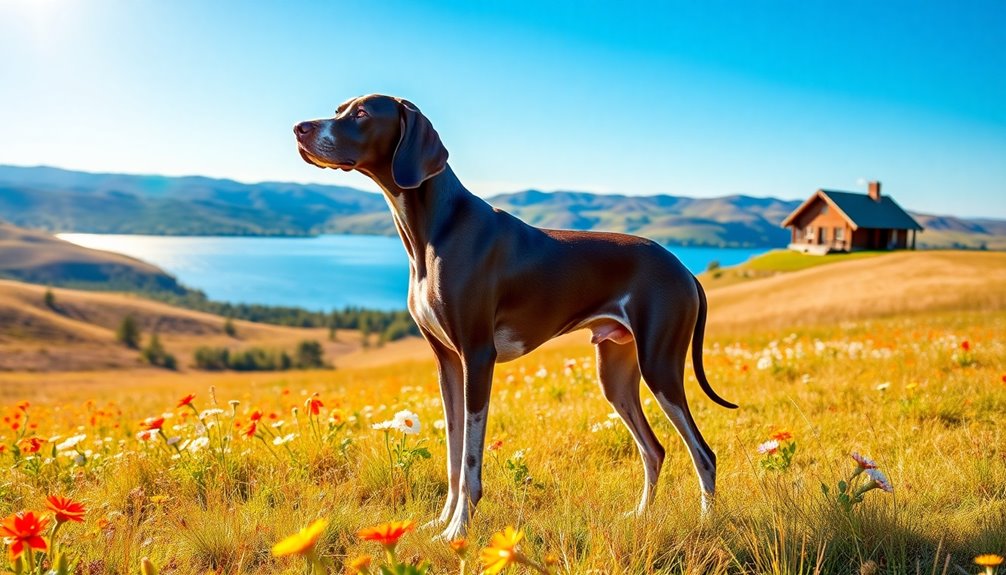
To keep your German Shorthaired Pointer happy and healthy, you'll want a house with ample outdoor space. They thrive in moderate temperatures, so consider your climate when planning their living environment. A secure, fenced yard will give them the freedom to run and burn off energy safely. Additionally, providing daily exercise is essential to meet their high energy levels and prevent boredom.
House With Ample Outdoor Space
Having a house with ample outdoor space is crucial for a German Shorthaired Pointer, as these energetic dogs thrive in environments where they can run, explore, and play freely.
Ideally, you should have a large yard or access to open areas, providing a secure, fenced space to prevent escapes and ensure safety. This setup allows your dog to burn off energy while exploring their surroundings. Additionally, these dogs require ample exercise to maintain their physical and mental well-being. Regular exercise is essential to prevent obesity-related issues, which can affect their overall health.
These active dogs require at least two hours of vigorous exercise daily. Think long walks, strenuous hikes, or exciting games of fetch to keep them happy and healthy.
Without enough physical activity, they may become bored, leading to destructive behaviors. Engaging them in mental stimulation and brain games is also essential.
German Shorthaired Pointers are social and love spending time with family, including children and other pets. They thrive on interaction, so your outdoor space should encourage family activities where everyone can participate.
Whether you live in a rural area or an urban environment, as long as you provide sufficient exercise and a safe place to play, your GSP will adapt well and lead a fulfilling life.
Prefers Moderate Temperature Ranges
German Shorthaired Pointers thrive in moderate temperature ranges, making it essential to maintain a comfortable indoor environment for them. The ideal indoor temperature hovers between 68-72°F (20-22°C). Keeping a stable temperature is crucial for their comfort, especially after outdoor activities in colder weather.
Ensure their beds are in draft-free areas and provide cozy, insulated bedding for added warmth.
While these dogs have a moderate tolerance for cold, their short, dense coat doesn't offer sufficient insulation for extreme conditions. Prolonged exposure can lead to hypothermia, so it's wise to limit their time outside in harsh winter weather. Additionally, their short coat increases sensitivity to cold temperatures, making it even more important to monitor their comfort levels.
When you do take them out, opt for shorter, more frequent walks, and watch for signs of discomfort. After outdoor play, allow them time to warm up indoors.
Behaviorally, they may seek warmer spots or exhibit reluctance to go outside when it's cold. Recognizing these changes is vital for their well-being.
Always ensure they don't sleep outdoors during winter, as additional care, like warm clothing and shelter, is necessary in colder climates to keep them healthy and comfortable.
Versatile in Multiple Hunting Roles
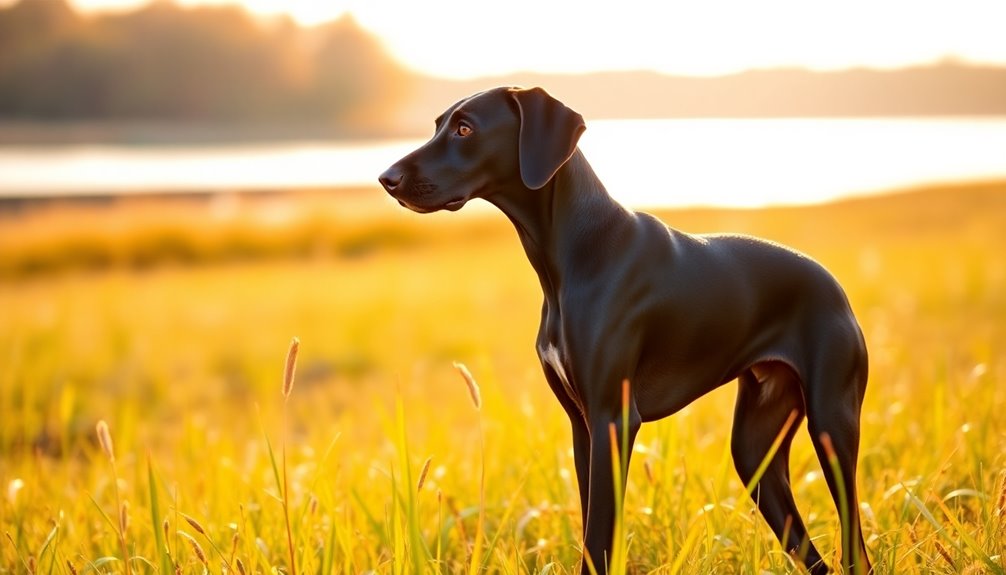
When you think about a hunting companion, the German Shorthaired Pointer stands out for its versatility.
These dogs excel in multiple roles, whether it's swimming to retrieve waterfowl or tracking game on land. Their strong swimming ability makes them reliable partners in any hunting scenario, just like the adventurous companions in Hollywood's "The Incredible Journey." Their innate hunting instincts allow them to perform reliably in diverse hunting scenarios, making them a favorite among hunters.
Strong Swimming Ability
Few breeds can match the strong swimming ability of the German Shorthaired Pointer, making them exceptional in versatile hunting roles. Their webbed feet provide excellent propulsion, allowing you to navigate through water with ease. The short, dense coat keeps them warm, enabling them to hunt in colder conditions.
With strong legs and a streamlined physique, these dogs can swim effectively, whether they're retrieving game or simply enjoying the water. Their proficiency in water is further enhanced by their high energy levels, which make them eager participants in aquatic activities.
Historically developed in the 19th century for hunting, they excel in retrieving waterfowl. Their moderately long floppy ears and broad, strong muzzle enhance their physical attributes, allowing them to carry heavy game effortlessly.
The expressive brown eyes reflect their alertness and intelligence, making them keen hunters.
Training your German Shorthaired Pointer to be comfortable in water is essential. Incorporating water work into their routine will keep them engaged and happy.
Socialization at a young age ensures they thrive in various water environments, capitalizing on their natural instincts. Their high energy levels and adaptability mean they're always ready for a challenge, whether it involves trailing, retrieving, or pointing game in wetland areas.
Hollywood's "The Incredible Journey
Having showcased their versatility in various hunting roles, German Shorthaired Pointers are celebrated not only in the field but also in popular culture, as seen in Hollywood's "The Incredible Journey." This breed excels in tasks like pointing, trailing, and retrieving game, making them ideal companions for hunters.
Their proficiency enables them to hunt upland birds, waterfowl, rabbits, and even deer, demonstrating their adaptability across various terrains such as marshes and ponds. Additionally, their strong athletic build allows them to navigate diverse environments with ease. These dogs are also known for their high intelligence, which contributes to their effectiveness in hunting.
You'll find that these dogs possess early-blooming hunting instincts, effortlessly introduced to live quail as young as seven weeks old. With minimal training, they quickly become competent gun dogs, showcasing their strong natural abilities.
Their endurance and powerful legs allow them to cover long distances, maintaining energy even in challenging landscapes.
Training is crucial, so you'll want to introduce them methodically to fieldwork tasks, honing their skills while participating in AKC Hunt tests.
Beyond hunting, they also excel in dog sports like agility and obedience, proving their versatility. Recognized as the "Swiss Army Knife" of hunting dogs, German Shorthaired Pointers truly shine in multiple roles, both on-screen and in the field.
Active Lifestyle Compatibility
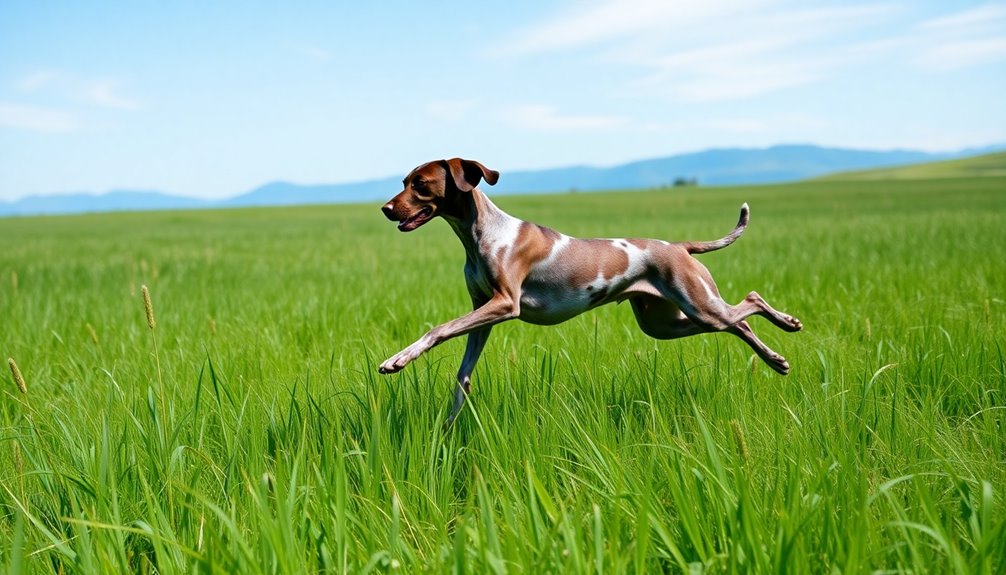
If you lead an active lifestyle, a German Shorthaired Pointer could be the perfect companion for your family.
These energetic dogs thrive on daily exercise and enjoy activities like running, swimming, and playing fetch. Consistent exercise not only keeps them happy and healthy but also strengthens your bond with them. Incorporating outdoor activities can also help you practice essential skills related to mastering the art of bug out bags.
Family-Friendly and Energetic Companion
German Shorthaired Pointers are often the perfect match for active families, as their energetic nature and affectionate temperament make them an ideal companion for those who enjoy outdoor activities.
These dogs thrive in households with older children who can match their energy levels. However, they may overwhelm younger kids, so supervision is essential during interactions to ensure everyone's safety.
Their friendly, outgoing personalities make them eager to please, and they form strong bonds with family members. You'll appreciate their loyalty, but keep in mind that their independent streak can make training a bit challenging.
With proper socialization, they can get along well with other pets, though their strong prey drive means they mightn't be suitable for homes with cats or small animals. To maintain their health, regular exercise is vital since they require significant daily exercise to prevent destructive behavior.
To keep a German Shorthaired Pointer happy, you'll need to provide ample time, attention, and mental stimulation.
A fenced yard or safe outdoor space is crucial for letting them run and play. If you lead an active lifestyle and can dedicate time to training and exercise, a German Shorthaired Pointer can bring joy and companionship to your family like no other breed.
Commitment to Daily Exercise
Committing to daily exercise is essential for keeping your German Shorthaired Pointer happy and healthy. These active dogs need at least 1 to 2 hours of exercise each day, depending on their age, health, and energy levels.
Puppies and younger GSPs will require more frequent workouts, while senior dogs benefit from a moderate routine. Walking and running are great ways to meet their exercise needs, but don't forget about high-energy activities like playing fetch or Frisbee. Swimming offers a low-impact alternative, especially during hot weather, while hiking or trail running combines physical exercise with mental stimulation.
Agility training can also provide both physical and mental challenges. Durable and interactive toys can further enhance their playtime experience, ensuring they remain engaged and stimulated.
Mental stimulation is just as important as physical activity to prevent boredom and destructive behaviors. Engaging in interactive games like tug-of-war or hide-and-seek can keep your GSP entertained. Additionally, obedience and agility training serve double duty by offering both mental and physical exercise.
Frequently Asked Questions
How Much Exercise Does a German Shorthaired Pointer Need Daily?
Your dog needs at least 1 to 2 hours of exercise every day. This requirement can change based on their age, health, and energy level.
Puppies and young dogs might need more frequent activity to burn off that extra energy, while seniors may prefer a gentler routine.
Consistency is key; regular exercise helps prevent behavioral issues and keeps your dog happy and healthy.
Mix it up with walks, fetch, and mental games to keep things interesting!
What Types of Game Can They Hunt?
You can hunt a variety of game with your skilled hunting dog.
They excel at locating and retrieving upland birds like pheasants, quail, and grouse.
In water, they retrieve ducks and geese with ease.
They're also adept at tracking small mammals such as rabbits and raccoons.
If you're after larger game, they can assist in following blood trails for deer.
Their versatility makes them a great companion for any hunting adventure.
Are They Good With Children and Other Pets?
Yes, they're generally great with children and other pets! Their friendly and playful nature makes them excellent companions for kids, though you should supervise interactions, especially with younger children.
They're energetic, so teaching kids how to engage safely is important. With proper socialization and training, they also get along well with other pets, forming strong bonds and ensuring a harmonious home environment.
Just remember, regular exercise helps manage their excitement!
How Do I Choose a Reputable Breeder?
To choose a reputable breeder, start by researching their health practices and ensure they conduct necessary health screenings.
Look for breeders who prioritize the breed standard and have registered their dogs with recognized kennel clubs.
Ask about their breeding ethics and commitment to the puppies' well-being.
Visit their facility to observe the dogs' living conditions and temperament.
Finally, seek references from previous buyers to gauge their experiences with the breeder.
What Common Behavioral Issues Should I Be Aware Of?
When you bring a dog into your home, be aware of common behavioral issues. High energy levels can lead to excitability and destructive behavior if they don't get enough exercise.
You might also notice a strong prey drive, prompting them to chase smaller animals. Additionally, separation anxiety can develop if left alone too long, resulting in chewing and other destructive actions.
Consistent training and mental stimulation are essential to address these challenges effectively.
Conclusion
In conclusion, the German Shorthaired Pointer is more than just a skilled hunter; it's a loyal companion that thrives in active households. With its unique blend of intelligence, energy, and versatility, this breed can adapt to various roles, whether in the field or at home. If you're ready for a dynamic lifestyle and can provide the right training and socialization, adopting a German Shorthaired Pointer could be one of the best decisions you make.

